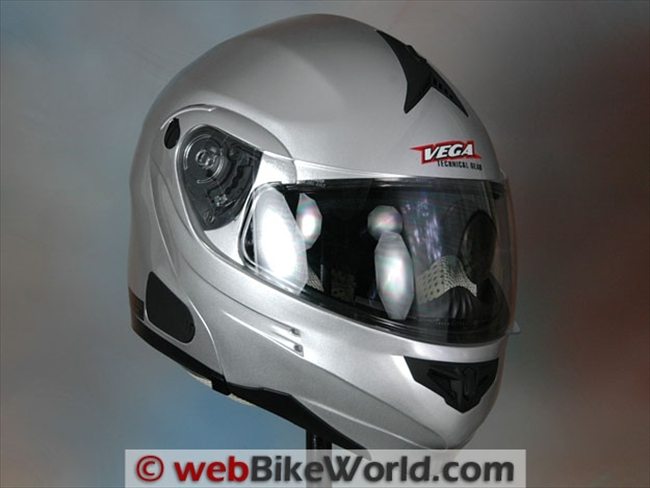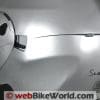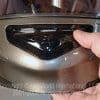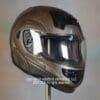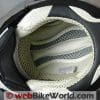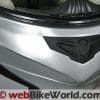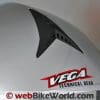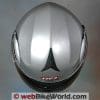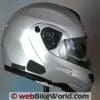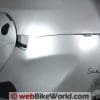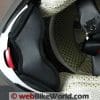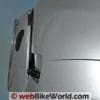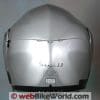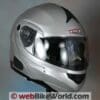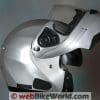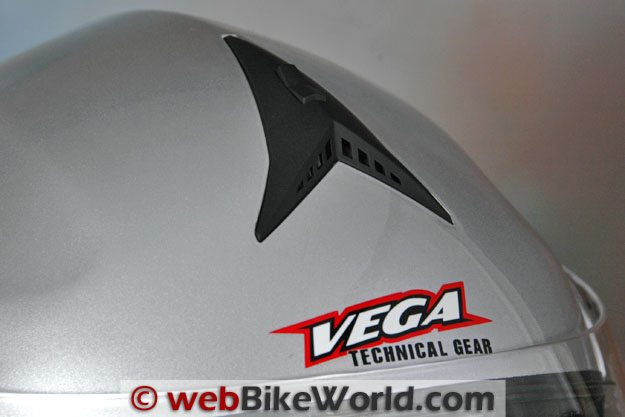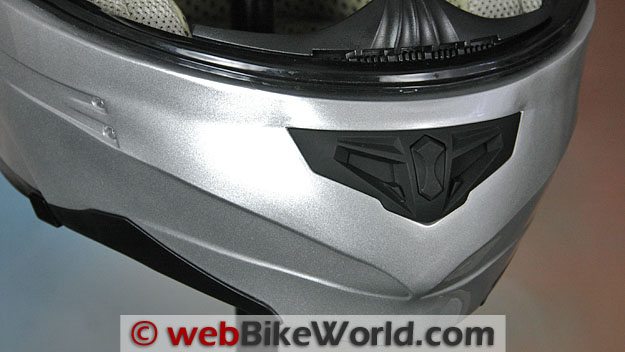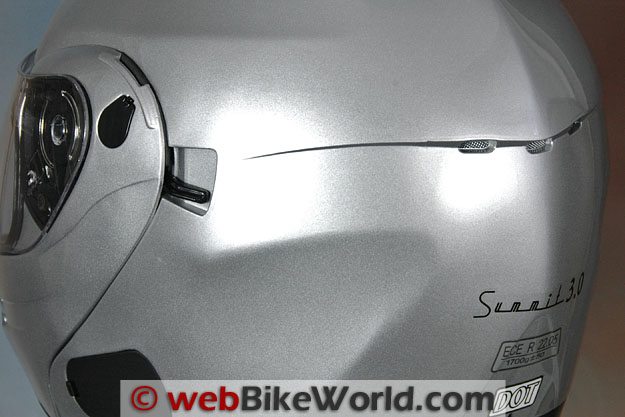It has a comfortable liner and a secure-feeling rotating visor and the price is right.
But is that enough?
I’m not sure when Vega first started selling helmets.
But the Vega Summit XPV was reviewed on webBikeWorld before our reviews had publication dates, so I’m estimating it was in the 2002-2003 time frame.
Flip-up helmets were gaining in popularity back then and the Summit XPV was a favorite, especially at the list price of $129.99.
Then in 2006, we reviewed the Vega Summit II, an evolution of the Summit XPV, which had become a popular flip-up helmet.
Helmet design and technology was advancing, but it was noted that the Summit II was a bit disappointing, which was probably a reflection of the competition and that the revised helmet wasn’t much different from the original.
The Summit II had a list price of $139.99, still a bargain.
Now it’s 2010 and we have the Vega Summit 3.0. It has a list price of $159.99 — not bad actually — but how has it changed and evolved from the previous versions?
In just the last 18 months or less, we’ve seen a big jump in helmet design improvements, quality and features.
It would be nice to compare the Summit 3.0 with other flip-ups in a sub-$200.00 flip-up shootout, and we’re hoping to get that done before the end of the year.
But in the meantime, let’s take a look at the Vega Summit 3.0 and see how it compares to its Vega ancestors.
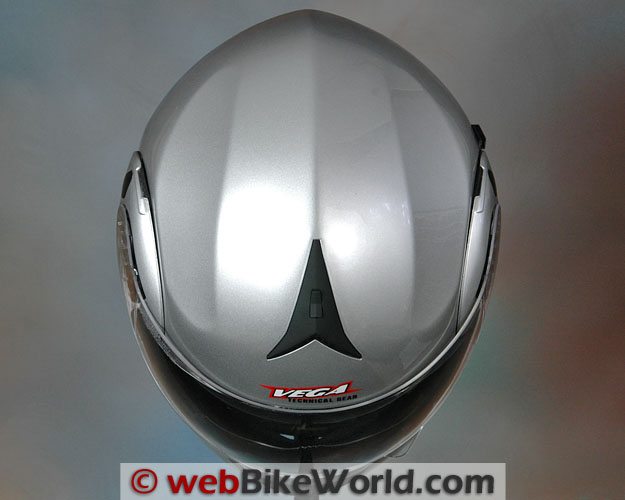
The Vega Summit 3.0 – Paint, Graphics and Overall Quality
The silver paint on this example exhibits good quality; it appears thick and it has a good-looking and relatively “deep” metalflake appearance. The clear coat also feels thick and it’s nicely applied.
There are a few surface imperfections in the helmet that show up as slight depressions, probably due to an over-zealous sanding during prep work. But this is a minor nit to pick and can only be seen in the side lighting of the video below.
So overall, I’d say that the paint and finish on the Summit 3.0 is generally excellent.
I couldn’t find any dust specks or orange peel and again, the clear coat deserves special merit because it feels thicker than the type used on some helmets costing much more.
The Summit 3.0 is available in three different black paint schemes (matte, metallic and gloss).
Those include the silver shown here; a titanium (darker silver) metallic and what appears to be the same red metallic used in our original Vega Summit XPV review. I would have ordered that color just for old time’s sake, but only the silver was available at the time.
The rest of the helmet seems to be made fairly well; adequate to average I’d say.
The rotating visor locking mechanism appears to use all plastic parts, but it locks solidly in place and stays closed with a hefty pull (see the video).
It’s difficult to describe subtle shades of quality differences, but everything on the helmet works well, it’s just that you know you’re not handling a $300.00 helmet.
When compared to, say, the Nolan N90 flip-up we reviewed recently, the cost-cutting in the Vega is apparent in just about every dimension.
With the Vega, this can be noticed mostly in the way the pieces are assembled, the subjective “feel” of the helmet and the design and operation of the vents and other moving parts, which I’ll describe in a minute.
So depending on how your stack your personal helmet choosing criteria, the Vega Summit 3.0 is either a real bargain or it cut too many corners; it’s up to you.
I can’t help but feeling though that the Summit 3.0 design, which really doesn’t seem all that different from the original Summit XPV, looks and feels a bit like an “old school” flip-up design.
My feeling is that the design just hasn’t changed all that much from the original — this one just seems to be like a 5+ year-old design.
In fact, from what I remember of the original XPV, Vega sort of went sideways, if not downhill, on the designs, with each successive helmet not really improving all that much on the original concept.
Perhaps the XPV was way ahead of its time — one of the reasons it was a favorite back then — or perhaps helmet design in general has evolved fast enough to make the Summit 3.0 feel a bit dated.
The best example I can think of is the venting, which worked much better on the original XPV than it did on the Summit II and now the Summit 3.0. But I’m getting ahead of myself…
In the end, the relatively low price of the Summit 3.0 may smooth the way for many potential owners to overlook some of its faults.
We’re planning on comparing it to other sub-$200.00 flip-ups like the HJC CL-Max, the AGV Miglia (review) and a few others, so stay tuned. Maybe the Summit 3.0 will be the best that money can buy in this price range, who knows?
Score: I’ll give the Vega Summit 3.0 an “Excellent” rating for paint and surface finish, all things considered. It gets a “Very Good” for the rest of the fittings. See the Summary Table at the end of this page for a description of our rating system
Vega Summit 3.0 Helmet Fit, Internal Shape and Liner
The Summit 3.0 is available in a size range from XS to XXL. I’m not sure how many shell sizes are used for this range, but my guess is that the largest shell is used for the L, XL and XXL and the smaller shell for the XS to M.
The reason I think this is because the thermoplastic shell on this size L feels pretty big, and the internal fit follows right along with that plan.
I think this size large fits one size bigger than expected; in other words, it feels much more like an XL than an L. This is apparent as soon as I put it on and in the feel of the shell.
The helmet also feels top heavy, which makes me think that there’s a lot more padding used in the size large, which would be the case if it uses the biggest shell size in the Summit 3.0 range.
Now I may be all wrong on this, but that doesn’t overcome the fact that the helmet just feels bigger than I expected in all dimensions.
Vega lists a size L as fitting a 59-60 cm head, and that size range is pretty much an industry standard for a size L. But I think this one would fit better on a 61-62 cm head, which Vega lists as an XL.
The oversize interior means that it’s a bit more difficult to evaluate the internal shape, but it definitely feels more round than narrow, so I’m calling this one a “Slight Round” in our helmet internal shape classification scheme. In fact, it may even border on full “Round”, so I’ll use the shaded red markers in the table below.
The lining has a better than average feel and comfort, which may be a result of the sizing with a large shell. The liner material is especially comfortable; more so than some very expensive helmets we’ve reviewed recently.
While it is difficult to compare the material to the plush fabric used in the new Shoei Qwest (review), the material used in the Summit 3.0 feels soft next to the skin, a definite plus.
The liner and its placement in the shell also has a quality look and feel, so no problems here. Except…for some reason, I can’t fit my sunglasses in the Summit 3.0 and others who have tried it had the same problem.
I’m not sure if it’s the design of the cheek pads or the large-feeling size of the shell, but this is worth noting because many motorcyclists purchase a flip-up helmet because they think it may be easier to wear eyeglasses (it usually isn’t).
One other thing to note is that the overall top-heavy feel and the shape of the helmet, along with a chin strap that doesn’t have enough padding (an unfortunate trend we’ve noticed recently) makes the chin strap very uncomfortable for me.
This may be a personal fit issue, but again, something to note.
The ear pockets feel shallow and they are lined with a hard plastic. They don’t seem to be well shaped for speakers, so I’d be interested to see what type of speakers Vega uses in the V-Com Bluetooth intercom version of the Summit 3.0.

More information on helmet fit can be found in the webBikeWorld Motorcycle Helmet FAQ page, along with the chart that lists the helmet weights of webBikeWorld reviewed helmets and also by shape on the webBikeWorld Motorcycle Helmet Shapes page.
Score: I’ll give the Vega Summit 3.0 an “Excellent” rating for comfort and liner materials and padding. The internal shape is rounder than most flip-ups, which may be a plus or minus, depending on owner preference. The chin strap gets a “Neutral” rating however.
Vega Summit 3.0 Rotating Visor, Face Shield, Eye Port and Visibility
I have to confess I still have a Duotec and wear it occasionally, even though it’s far beyond it’s “Use By” date.
The rotating visor on the Summit 3.0 opens and closes smoothly, although it doesn’t have the precision feel of the Nolan or the KBC FFR (review) I reviewed in 2005, with their metal parts.
The locking assembly in the Summit 3.0 appears to be made from plastic, and small tabs fit into a slot in the receiver in the helmet shell.
The system seems to work well and the visor feels secure when it’s closed and locked, but I think I’d feel better if the parts were metal.
The visor uses a central release button located underneath the center of the chin bar. The chin bar on the Summit 3.0 is huge; it measures 4.5″ tall, plus another inch for the breath guard.
This is also a factor in the overall large feel of the helmet and the chin bar affects the lower sight line, giving the eye port a lower than average rating for outward view.
The face shield on the Summit 3.0 has excellent optical qualities. It measures 2.27 mm thick, which is slightly thicker than normal (good). It is labeled as meeting the VESC-8 standard.
However, we have not been able to remove the face shield. There is no lever to push in the side rotator. There is a small two-way arrow molded on to the side of the face shield, which seems to indicate that the face shield can be pulled forward.
But try as we might, we have not been able to figure it out. [UPDATE (September 2013): See the YouTube video on how to remove a Vega Summit 3 face shield.]
The helmet has no owner’s manual; just a simple hang tag on the helmet that was confirmed as the only owner’s manual when we called Vega for instructions on how to remove the face shield.
The instructions were to lift the shield until the little tab on the inside meets the slot on the black rotating assembly.
We can see that, but the lip molded around the circular boss that acts as the rotator will not allow the face shield to come off. If anyone has been successful in removing the face shield on their Summit 3.0, please let us know how it’s done.
As I mentioned, the overall eye port visibility is lower than average, with poor visibility (sight lines) out the bottom, average to lower than average out the sides (probably due to the large shell shape) and average out the top.
The Summit 3.0 has an internally rotating sun visor, engaged with a lever on the left-hand side behind the face shield. The sun shade can be stopped at any position.
The bottom edge is highly curved, as you can see in the video, and this is somewhat annoying because it remains in the line of sight.

Score: I’ll give the Vega Summit 3.0 a “Very Good” rating for the overall quality and operation of the face shield and eye port, but a “Poor” for the face shield removal mechanism and outward visibility.
Ventilation and Air Flow
This is where the Summit 3.0 really shows its old-school roots. The top vent consists of a small hole in the shell, with a tiny rocker switch that lifts a cover over the vent.
Air flow feels minimal at best and non-existent at worst, despite the single hole through the EPS liner, which is unfortunately covered by the top section of the fabric liner, effectively blocking any air that might find its way through.
The chin vent also uses a small rocker switch; it opens horizontal vents on either side, but the air apparently has nowhere to go — even the top of the chin bar seems to have no place for the air to flow.
I can blow through the chin vent and feel nothing along the top of the chin bar or anywhere else, so the system needs some improvement, in my opinion.
The helmet has a removable chin curtain, but it has an opening in front to allow access to the visor release. A lot of air blows up through the hole, providing the air flow that the chin vent doesn’t, whether you need it or not.
So overall, I’d have to rate the venting system on the Summit 3.0 as poor. It’s a shame, because the ventilation has gone from good on the Summit XPV to mediocre on the Summit II to poor on the Summit 3.0 in my opinion.

Score: Back to the drawing boards on this one Vega; I suggest breaking out an old Summit XPV to see what worked. This one gets a “Poor”.
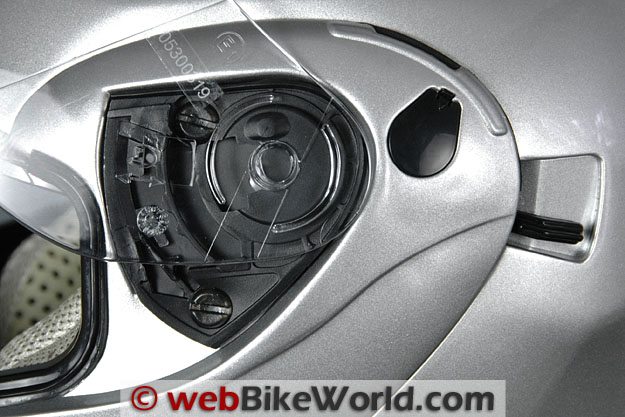
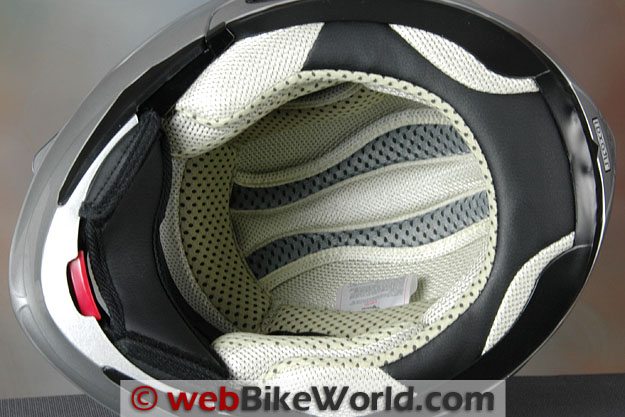
Vega Summit 3.0 Sound Levels
But overall, I’d say the noise levels are average to slightly above average, mostly due to the wind coming up from under the chin bar, despite the chin curtain.
The shape of the shell seems to cause some wind noise along the bottom edges of the helmet and the large-feeling shell also has some lift and pressure when my head moves side-to-side, which again may be due to the shell shape and fit issues.
So overall, I feel that the Summit 3.0 is about average when it comes to noise control. “Average”, when it comes to motorcycle helmet noise, equates to “loud”, unfortunately, so always wear ear plugs!

Note that our helmet evaluations are a combined effort of several riders over time on different types of motorcycles with and without windscreens.
Evaluators wear correctly fitted, high quality ear plugs (even when evaluating motorcycle intercom systems).
Always protect your hearing when riding a motorcycle. See the wBW Earplug Reviews for more information on choosing and wearing earplugs.
Note also that perceived noise levels will vary, depending on the individual.
Noise can be caused by many factors, including helmet fit, the type of motorcycle and windscreen, wind speed and direction and even the rider’s clothing.
For more information on helmet noise, visit the wBW Motorcycle Helmet Noise page.
Score: I’ll give the Summit 3.0 a “Neutral” rating for average noise control.
Helmet Weight
The Summit 3.0 is, like most flip-ups, fairly hefty. That being said, it’s actually a bit lighter than some of the other monsters we’ve reviewed, although it’s hard to compare because of the mixture of sizes (L and XL).
The Summit 3.0 weighs in at 1789 grams (3 lbs., 15-1/8 oz.) which is just shy of the don’t-go-there number of 1800 grams (call it 4 pounds). We haven’t weighed an XL, and it may just touch the 4 lb. barrier.
Combined with the top-heavy feel, this makes the weight noticeable, although the comfy liner and padding helps a bit.
For comparison’s sake, other flip-up helmets in this range include the HJC Sy-Max II in size L at 1762 grams and the original Vega Summit XPV in size XL, also at 1762 grams.
That shows that once again that Vega may have gone backwards, rather than forwards, on the redesign (although the Summit 3.0 has the internal sun shade).
Other heavyweights include the Caberg Sintesi 2 in size L at 1772 grams; the HJC IS-Max (both L and XL) at 1803 grams and topping the charts, the SCHUBERTH C3 With SRC in size XL at 1851 grams and the Shark Evoline (L) at 1928 grams.
The massive Suomy D2 in size XL broke the scale at 2003 grams.
In general, the plastic or polycarbonate shells are heavier than their composite fiberglass/Kevlar counterparts, but polycarbonate is a lot less expensive.
All of these weights are available on the wBW Motorcycle Helmet Weights page, along with a chart that lists the helmets by weight and shape on the wBW Motorcycle Helmet Shapes page.
Score: I’ll give the Summit 3.0 a “Neutral” rating for its weight, that is pretty much typical for this type of flip-up helmet.
Miscellaneous
Vega claims that the Summit 3.0 meets both DOT and ECE 22.05 safety standards.
The liner is removable and said to interchange within a size range that they list as XS-M and L to XXL, which confirms to me that there are only 2 shell sizes across this wide range of helmets.
The warranty apparently isn’t listed; it’s not on or in the box and I couldn’t find a reference to a warranty on the Vega Helmets website.
| webBikeWorld Overall Opinionator – Vega Summit 3.0 | |
|---|---|
| Picks… | …and Pans |
|
|
Conclusion
In the meantime, I can only speak to my experience with this helmet over the last few weeks. Would I buy it? Probably not; I’d rather spend some extra money and stick with my Shoei (now the Multitech) or one of the new Nolan flip-ups.
But there are a lot of bargain hunters out there and as long as they’re not as fussy as me, they will probably be satisfied.
More: wBW Motorcycle Helmet Reviews
| wBW Product Review: Vega Summit 3.0 | |
|---|---|
| Manufacturer: Vega Helmets | List Price: $$159.95 |
| Colors: Solids and mettalics | Made In: China |
| Shell Sizes: Unknown | Review Date: October 2010 |
|
Rating Scale is subjective: Unacceptable, Poor, Neutral, Very Good, Excellent, Outstanding.
|
|
Owmer Comments and Feedback
See details on submitting comments.
From “A.S.” (September 2013): “You asked to us to let you know if we figured out how to change the face shield on the Vega Summit 3.0 helmet.
I cannot use this as proof of what a great genius I am, as Vega has a video on YouTube showing the method. The only trick was finding it… hey, maybe I am a genius!”
From “G.D.” (03/11): “I just read your review of this helmet and wish I had done so before purchasing it.
I have had several other modular helmets and waited with much anticipation to see the new Vega model, mostly because of the addition of the drop-down sun visor.
Sadly, what they added in a sun visor did not make up in any way for the balance of the helmet, which I have to rate as a pretty poor effort.
The best part of the helmet is the interior padding and the cool bag the helmet comes in. The worst part is the enormous chin bar which is HUGE compared to my other modulars.
When in the up position, it looks completely out of place and you wouldn’t believe some of the stares I would get when walking around that way. This is not true on the other modulars I have.
As you pointed out, the air flow is non-existent from the vent system. Since the interior deflector seemed to do no good anyway, I removed mine so that I could improve the visibility, which is pretty poor as you mentioned.
The ear pockets are almost non-existent, so forget about installing anything other than the thinnest helmet speakers. The release mechanism on the visor is ridiculous as you and the other readers have commented.
You literally need to tear the visor off to replace it and I too thought I was going to break it (I didn’t) in the process.
BTW, the interior sun visor is NOT replaceable as advertised, which I confirmed directly with Vega… Nor is it dark enough to help in bright sunlight.
The chin strap was flimsy as you noted, so I replaced it with buckle system that I stripped-off one of my out-of-service AGV Miglia helmets (review).
That solved that problem, but I am still stuck with a very heavy and top-loaded helmet that looks kind of stupid when open. Even though it is the right size, it simply does not feel right, so lesson learned.
All I can really think of doing with it at this point is to just toss it away. I am a committed modular helmet guy and my quest to find the perfect one remains unfulfilled.
While I haven’t found it, I do like some of the features on the Nolan which I have only tried on.
I have purchased 4 different brands of modular helmets now and I must say that even my ultra cheapo and not really great VOX Modular puts the Vega Summit 3.0 to shame.
I also have the latest modular from Zox which is OK, but it is also fairly heavy and noisier than others I have tried.
I am still a big fan of the AGV Miglia which remains my daily rider and is I believe, the best modular overall that I have found under $200.
I wish it had a good drop down sun visor to help on those late afternoon rides, but I guess I will just have to continue carrying darker shades with me for those times.
I hope this helps others in their buying decision. I ride a lot (almost 19,000 miles since last March, even while living in Chicago) on my Honda VTX1800F and I know how important it is to get good input from fellow riders.”
Response From “M.R.” (04/11): “Please pass this link on to the happy AGV Miglia owner who bemoans the lack of an internal sun visor.
I purchased this item (the Miglia sun visor from RevZilla) for about $35.00 a year ago and the only thing I try to do is keep the space between the two visors clear to avoid scratches. Please keep up the good work.”
From “B.C.” (12/10): “I am both a cyclist and a motorcyclist. I wear a helmet whether the motor is powered by gasoline or an energy bar and I’m quite familiar with helmet air flow because of my cycling experience.
I have owned both the XPV and the Summit II. The XPV had an air intake but no air channels for air flow across the head there was a gap between the shield and the rubber seal which allowed a terrible downdraft and rain inside the shield.
Raising the chin bar required that I use both of my thumbs on the button of the XPV while the Summit II release mechanism was much easier. The Summit II didn’t have a gap between the shield and the seal and had air channels inside the helmet which were improvements over the XPV.
My Summit II has developed a stripped screw hole where the chin bar hinges after two and a half years of almost daily use. I tried to switch back to the XPV but the chin bar release button broke off.
The chin bar hinge screws occasionally came loose and needed tightening; this was my only complaint about the helmet.
I just checked out the Summit 3.0. It has a sun visor that goes up and down by using the lever on left side but that’s the only improvement over the II.
Vega has seemed to have taken a tip from the XPV contrary to your statement in that they need to and now the air channels that were in the Summit II are no longer existent in the 3.0.
I didn’t check for a gap between the shield and the rubber seal. After noticing the lack of air flow in the 3.0, I decided to look at other helmets.
In my personal opinion, Vega and just about every motorcycle helmet maker should take a look at and a few tips from the better bicycle helmet makers when it comes to air flow and channeling it for maximum cooling.”
From “D.K.” (11/10): “I bought one. I feel that it’s a poor product due to the the failure of the button you grab open the helmet up.
The wire inside snapped. Upon taking it apart I found some of the screws inside that hold the side locks closed not that tight.
Quoting you “The warranty apparently isn’t listed; it’s not on or in the box and I couldn’t find a reference to a warranty on the Vega Helmets website”.
They really don’t have any warranty or parts. I phoned them up twice asking for warranty replacement. No one seem to know what to do.
After demanding a replacement I was told I was rude for interrupting the woman on the other end of the phone 3 times saying I want a replacement helmet. They she said I’m to only contact them by mail. Then she hung up on me.”
From “R.G.” (11/10): “Open the visor until the peg on the visor lines up with notch on the helmet, grab the side of visor and pull it straight out of the pivot notch.
You’ll need to lift that small peg on the visor up a little to clear the black holder.
Hope this helps. It’s cheap, but it works smooth and locks in all positions well, and best of all, you can removed it without tools.”
Editor’s Reply: This is pretty much what we tried, but the amount of force required seemed like it might break something. Perhaps we didn’t pull hard enough.


